As an Amazon Associate I earn from qualifying purchases.
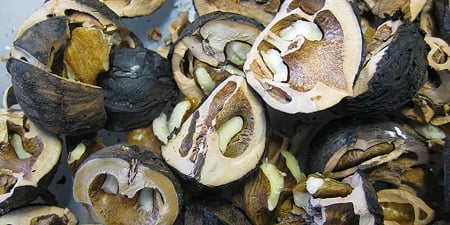
You’d think that if anything would bring out the Greed of Man in me, it would be truffles, a sexy, intoxicating food that can fetch $300 a pound or more. Yet I’ve given plenty of them away to my friends without a second thought.
No, what really makes me feel like Gollum from Lord of the Rings, the wild food I hold most precious, is my store of shelled black walnuts. Don’t even ask. You can’t have any. They are mine I tell you, all mine!
For those of you who don’t know what a black walnut is, it is a generic term for the wild walnuts native to North America. There is one main species east of the Rockies, two in California, and a couple of others in Arizona and Texas. Black walnuts are, more or less, related to hickory nuts and butternuts.
What’s the difference between black walnuts and the kind you get in the store? The vast majority of walnuts you buy in stores are English (also called Persian) walnuts, which are larger and easier to shell than black walnuts. In some places you can buy them in stores, and you can buy black walnuts online.
Size is not the main difference between black walnuts and domesticated ones. Flavor is. Black walnuts taste far stronger than regular ones: More concentrated, walnut-y, and even a touch more bitter.
To me they are the difference between cream and skim milk, grouse and chicken, a wild strawberry and one of those gigantic ones grown on the coast of California. I will take black walnuts over regular ones any time, and for any price.
Luckily that price is free: Black walnut trees grow all around us here in Northern California. My friend Josh tipped me off to a great spot, too, which has so many old trees it took my just 10 minutes to fill two 5-gallon buckets.
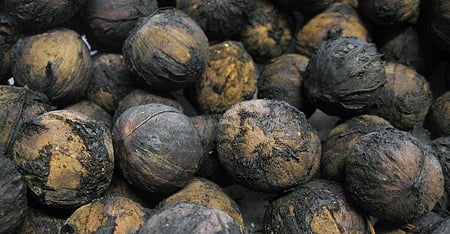
OK, maybe I lied. Black walnuts are not free — if you take time into consideration. Nothing I have ever done, not winemaking, gardening, big-game hunting, processing acorns or curing olives is as labor-intensive as harvesting, hulling and shelling black walnuts. As my fellow forager Connie Green says, “black walnuts are a fortress.” Here’s the method I figured out to storm the gates.
First you need to harvest the walnuts at the correct stage of ripeness.
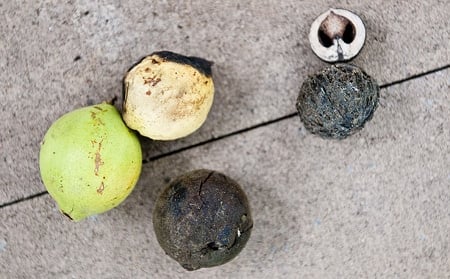
For starters, walnuts will probably not be ripe where you live until October, so wait until then to begin. November should be fine, too, and you can pick up fallen nuts from the ground around the trees into December, but by then our Little Gray Friends the squirrels will have had at them.
So you’re standing at a tree. You see all these forms of walnuts in front of you. Which to pick?
Green ones will most likely still be on the trees. Yes, you can collect them, but they have a surprise in store for you. The beige ones are rotting green ones — they are the hardest to work with, but the nut inside will still be fine. The black one at the bottom is how you will find most of your walnuts: It has its hull rotted and is pretty dry. Finally, if you’ve had lots of rain, you will find some nuts that will be pre-hulled, like the one under the half-shell.
Pick only pre-hulled walnuts that feel heavy for their size, as they will dry out in the shell once hulled.
For the most part, you will need to hull your walnuts. Lots of people say you should just drive over them with a car, but this stains your driveway. Stain? Why yes. Black walnut juice stains like nothing else. And it will not come off with any amount of scrubbing. If you fail to wear gloves when you hull black walnuts, you will have the Black Hand of Death for several days.
Sam Thayer, in his book Nature’s Garden, suggests stomping on the hulls in the field to get them off. This works, but incompletely in my experience with Northern California walnuts, Juglans hindsii. So I sit outside on my porch with three buckets — one with walnuts in it, one for the soon-to-be-hulled walnuts, and one for the hulls. I then don gloves and use a pocketknife to hull the nuts by hand.
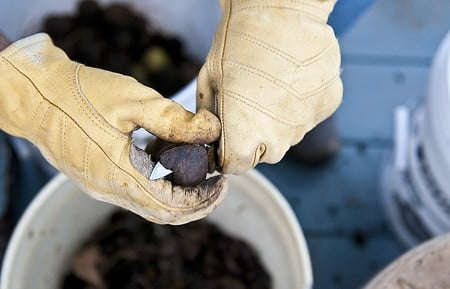
You want a relatively dull knife that you can slice with and not be in danger of it piercing your work gloves. The work can get a little slippery, especially with the green walnuts — remember the surprise? That’s it. A half-hulled green walnut is slipperier than goose shit on a doorknob. This is why I prefer the walnuts with the fully rotted black hulls.

Beware when you are hulling walnuts outdoors. Our Little Gray Friends could be lurking anywhere, just waiting to steal your walnuts for themselves. I use a biological countermeasure to keep the squirrels away:

Once hulled, your work has just begun. Now you must shell your walnuts.
This is the point at which you can kick back a bit. Hulled walnuts store well in the shell, and in fact crack better once they’ve dried for a few weeks.
Once you start shelling, however, you need to banish from your head all notions that you will be able to crack black walnuts and get those pretty perfect halves you can get with regular walnuts. Won’t happen. Bits and pieces are the price of precious black walnut meats.
I crack mine with a hammer, on the concrete floor of my garage. Such force is necessary. I’ve never heard of a regular nutcracker fierce enough to break a black walnut, although some people in the Midwest, where the Eastern species lives, have created special black walnut shellers. Anyone ever use one? I’ll buy one if they work well…
The key to the hammer technique is to use a terrycloth towel to cover the nuts, so the pieces don’t fly all over the room. Use a towel you don’t care about, as it will get holes. Smack the nut with enough force to break it, but not enough to pulverize the nut; after a few, you’ll get the hang of it.
So now you have a bucket of cracked nuts. You’re still not done! Now you need to gently remove the meats from the impossibly complex interior of the walnut. I find the best piece of equipment to do this is a stout pair of wire cutters and a nutpick. I use the wire cutters to clip the shells in key spots so larger pieces of walnut fall out. Again, after a few dozen nuts you’ll begin to know where to clip. The nutpick’s use is obvious. This is tedious work, people. I do it while watching football.
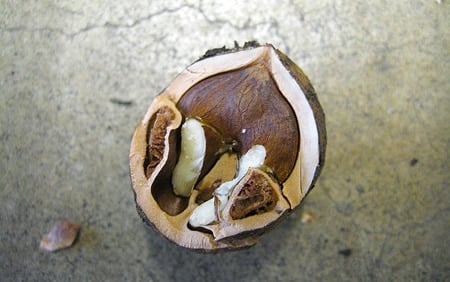
Let me tell you before you begin a black walnut adventure that you need to be patient. It took me probably six hours of work to get 15 ounces of nutmeats — although that includes hulling all of my nuts, not just the portion I cracked and picked. But all this work is worth it.
Just the aroma of black walnuts is payment for the effort: They smell toasted without actually being so. And I’ve already mentioned the flavor, which is so strong many recipes say just half the amount of black walnuts will fully replace the flavor of regular ones. I’m not so sure about that, but you can use a bit less. If you want.
Which brings me, finally, to what I do with my black walnuts. In holiday season, I make a Christmas cookie from my childhood:
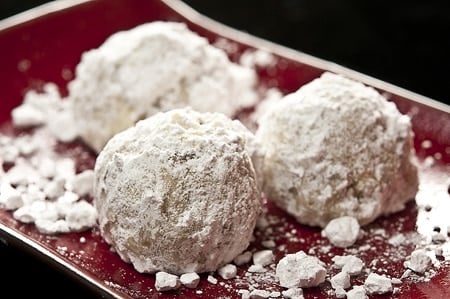
It is my version of a traditional walnut snowball cookie, also known as a Russian teacake or a Mexican wedding cake. My version has black walnuts, of course, but also orange flower water and a little orange liqueur. It’s an awesome cookie, a riff off one my mum has made for decades.
These cookies are stupid easy to make — no mixer necessary, just clean hands — and are so good you really need to make a double batch, because you will eat half of them before your friends or family come home. Trust me on this one.





I use a vice to crack my black walnuts. Works great and the meats do not get crushed.
Come to Indiana and I will show you what a black walnut looks like. I live in the foodie town of Bloomington and we have the trees growing like weeds here. True black walnut spices grow here. True back walnut trees and nuts are native to the Great Lakes States and no where else. I learned all about black walnut trees as a kid. I am pretty sure that the photos in this article are not of true black walnut. They are some other type like English walnuts. I do see recipes for walnuts but, I think many times they are calling for another type as true Great Lakes Black Walnuts are hard to come by outside of the region in which they grow naturally. Like I said, come on by and gather some in June for pickling or in September for gathering for their nutmeats.
Jo: There are several species of wild walnuts all over North America, not just the Midwestern one you are referring to. I can assure you the walnuts I use are natives, but yes, they are not the same species as in the Midwest. Sorry for the confusion.
I read somewhere that freshly hulled black walnuts should be rinsed in a bucket, and if they float, toss them. I just treid this, and 2/3 of them floated?
Do I toss these?
Brian: Maybe? You are so late in the cycle the nutmeats will have shrunk, which can cause the floating. Keep in mind you will have fresh walnuts in a couple months. Yours will be 10 months old.
I use the hulls for a lovely natural dye , and my favorite recipe is for black walnut pound cake. My aunt also makes yummy black walnut cookies. Oh, there is nothing like black walnuts!
This will probably get lost amongst all the other comments, but an older neighbor of mine uses a brick to crack his walnuts. Something about the mass of the brick pops them right open, doesn’t require much force at all. And it does it without crushing them. He collects buckets of them every fall.
It’s early august and the neighbor sadly cut down their black walnut tree. We collected the walnuts however they are very green. How do you recommend that we ripen them up? Will they ripen by themselves with time? We have about four 5gallon pales full and would really like to make use of them. Any advice or thought are helpful. Feel free to shoot me an email in response. Thank you.
Katie: No, they will not ripen. Give them to the squirrels. Sorry.
Look for a Grandpas Goody Getter black walnut cracker. Works really well.
I totally agree with you Judy, just purchased one and it works perfectly.
Seconded. Late to the party here (per usual,) but Grandpa’s Goody Getter/Nut Cracker makes smashing these little buggers an autumn’s afternoon’s hoot– and if you can round up a couple of credulous neighborhood kids to do the dirty work, they’ll have a blast wreaking carnage for you.
I’ve had mine for fifteen years now and tens of thousands of crushed black walnuts later, it’s still as efficient as the day I got it. An American heirloom quality gadget on a par with the best hand-hewn, wood-handled garden tools. (Works on macadamias, too.) Highly recommended.
Monty Peck, that’s an interesting survival tip! Sounds a bit crazy…maybe like a snipe hunt. Also seems a little naughty, but potentially useful in an eat-or-be-eaten scenario. 🙂
I just cook the dehulled (or mostly dehulled) but in the oven at 300 degrees for an hour or two, and the nuts pop right open along the seam. A dull but strong butter knife will pry it open the rest of the way.
There is a use for the green hulls if you are ever in a survival situation and are near still water with fish in them. Pound the hulls with a rock to crush them. since it is a life or death you won’t have a burlap bag to put them in but a t-shirt will work, so tie off the neck & sleeves. Put the hulls and a large rock in next and tie off the bottom. drop the shirt in a deep pool. In a little while fish will start to rise to the top. The tannic acid makes the oxygen unavailable to the fish and they will drown. Hopefully by then you have a fire to cook on.Don’t forget to retrieve your shirt.
If you have a ringworm on your skin. Sometimes kids catch them from cats. You can pull a green walnut from the tree and open the juicy green hull and rub it on the ringworm after a few regular applications the ringworm will be healed. And oldtime farm cure from my grandma. Used on us as kids worked well.
If you have poison ivy on various parts of your body, make a tea with the black outer hulls, strong, and pour it in bath water. What a relief it is.
There is a walnut saw that cuts the walnut so it can be opened and bigger pieces removed. Sometimes halves. https://www.youtube.com/watch?v=_5p8jbxUIRA
Wonderful post, thanks! Do you know where I can get black walnuts (with shells) in or around Sacramento or the Bay Area?
Natasha: They’re all around you! You need to look for the black hulls under the trees now.
Grandpas Goody Getter is the best black walnut cracker/ sheller there is (in my opinion).
This is my first year harvesting black walnuts in NJ and I have to tell you I have harvested about 1,000 nuts with this device this year. It cracks them from above and below fast and efficient, just grease it as they say, great leverage. Check it out.
Yes black walnuts are a Pain-ITA but they are worth it and Grandpas Goody Getter gets the job done to where you can get at the nut meat without a lot of hassle. It comes with a great pair of clippers to dissect the nut shells that just won’t release the meat.
P.S. I just stomp on them as I harvest to get the nut and leave the remains in the field where they belong. It works as good as any other method.
I’ve read that a good bench vise will also work
A hammer…. I use a geologist mallet.
Welders wire cutters and dental picks.
Maybe a pair of safety glasses.
And need I say they are well worth the effort.
Jose
There are nut crackers on ebay..one is a black all metal with kind of double action. You put the nut in between the teeth and pull down the lever. After a while you can get almost whole nut meat
Hi! Delighted to discover your site & all the info about black walnuts. I watch each year as cars run over them but never see anyone picking them up so-o-o I decided to venture out .I’m 72 young so don’t collect to many, just for fun & see if I can do it. Your article on Black Walnuts left me laughing at your “biological” squirrel deterrent,& people’s suggestions to run over with car. I have been picking up “run over” green hulled ones as well as non-run over. some have worm holes but guess ok. 2 thumbs up to you Hank!!!
Use a flat tip shovel to pick the walnuts up off the road. I’m 76 years young and I have been cracking walnuts almost all my life.
I really appreciate your article. Also the other comments are helpful. I live out in WA state and have a tree over 100 years old. This year I have more than I have ever seen. If I lived in the central US I see I could get $15 per hundred lb I think I could say easily sell 1000 lbs for a cool $150 haha. I may harvest some if I get the C E Potter nutcracker I see on eBay right now.
thanks
When I was a kid, 60 years ago in Houston County Minnesota, we would go out to the woods and ‘pick’ nuts. We didn’t really pick them, we just picked them up off the ground. Until I was 30 or so, I thought those were the only kind of nuts there were. My Mom baked them into everything. They were delicious. Then I got married and my wife would buy English walnuts at the store for baking. There were okay, but not near the flavor of the nuts I grew up with, BLACK walnuts.
Yes, black walnuts are prettymuch impenetrable. You need hammer on vise or anvil. I don’t know how squirrels get them open. I bought some hickory nuts on the I-net. You can’t buy them at any store. Also very hard to crack, but delicious. So, if you’re a black walnut freak, I’m with you. My wife hates them. More for me.
We planted two black walnut trees forty years ago and have always been pretty prolific once they started producing. They’re also responsible for a number of other trees in the neighborhood thanks to the squirrels, both red and gray. We especially have to watch out for the little red ones as they like to use the engine compartment of our cars to build their nests and store nuts. This year our trees have been especially prolific and neither we or the squirrels are keeping up. There seem to be less squirrels probably due to the influx of coyotes in our area. Anyway we decided to check into recipes which eventually brought me to this site. We will certainly be trying out some.
I have a Kenkle Hardshell Nutcracker – works pretty well. I have it mounted on a board. I crack walnuts while we watch mindless TV – I think it’s healthier than eating ice cream;)